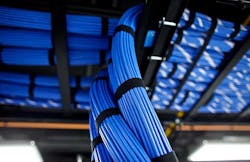Today we continue our Data Center Executive Roundtable, a quarterly feature showcasing the insights of thought leaders on the state of the data center industry, and where it is headed. In today’s discussion, our panel of executives examines how the pandemic has impacted data center networks and interconnection. Our panelists include Phillip Marangella of EdgeConneX, CoreSite’s Juan Font, Angie McMillion from Vertiv, Kevin Facinelli from Nortek, Digital Realty’s Tony Bishop and Jaime Leverton from eStruxture Data Centers and Infrastructure Masons.
The conversation is moderated by Rich Miller, the founder and editor of Data Center Frontier.
Data Center Frontier: What do you see as the most important trends in data center connectivity and interconnection, and how have they been impacted by the COVID-19 pandemic?
JUAN FONT, CoreSite
Juan Font: We are seeing interconnection become an even more important decision-factor for deployments – especially within the enterprise segment. The enterprise IT decision makers are coming to us with more knowledge about how to utilize colocation within a holistic IT strategy.
I think COVID-19 is going to force enterprises to shift focus away from on-premises data centers. Data center managers are realizing that colocation providers can do a better job at maintaining a mission-critical space, especially during unprecedented circumstances. And this will open up resources for more activities that focus on the enterprise’s core function.
PHILLIP MARANGELLA, EdgeConneX
Phillip Marangella: As our homes have become the new Edge where we work, watch, study, and play we are seeing a huge push to increase network and data center capacity at the Edge to alleviate those traffic bottlenecks and ensure that the User Experience continues to be a high quality one.
Peering, interconnection and smart routing of traffic from Edge data centers will be key to efficiently and effectively ensure that cloud applications, video conferencing, streaming content, on-line gaming, and many other applications maintain a premium quality of service and experience.
TONY BISHOP, Digital Realty
Tony Bishop: It’s no longer a matter of if enterprises are adopting cloud strategies. Instead, multi-cloud is emerging as a way to enhance security, scalability and flexibility within the enterprise, yet it also surfaces additional complexity that today’s modern enterprises must overcome. To do so, enterprises must rely on software-defined networking (SDN) to quickly and securely connect to not only each other, but cloud service providers and the web of data centers around the world. The use of SDN technologies enables enterprises to access any destination from a central location while supporting multiple connections to service providers, including public clouds. This gives enterprises more flexibility and reliability, especially as they face evolving bandwidth requirements.
For instance, our customer, Surfnet Communications found itself with the sudden need to provide more bandwidth to its customers as they started to work from home amid the COVID-19 pandemic. By partnering with Digital Realty and utilizing Service Exchange, Surfnet was able to overcome bandwidth issues and service customers from anywhere. COVID-19 demonstrated the need for a stable infrastructure that could support our economy during turbulent times, and an important part of this was interconnectivity.
Our number one goal remains to ensure safety while supporting customers with the critical infrastructure and uptime needed to power today’s digital businesses. During COVID-19, in partnership with Megaport, we launched an offer to waive port fees for new ports on Service Exchange to anyone in critical industries like government, medical emergency services and education verticals for six months. Available worldwide, this offer enables critical services to connect to over 350 service providers and 167 cloud onramps globally.
As organizations reevaluate their priorities and budgets to progress digital business post-COVID, we need to keep in mind the challenges we need to overcome as data continues to grow, especially as a result of a more permanent remote workforce. Moving forward, we’ll see this trend continue to accelerate as companies look for ways to add flexibility and connectivity – from anywhere.
ANGIE McMILLIN, Vertiv
Angie McMillin: In the past six months, we’ve seen a surge in demand for remote IT management solutions such as KVMs and serial consoles that reduce physical interaction with data center systems. As we’ve seen in other areas of society, technologies adopted out of necessity that demonstrate their value can generate longer-term changes in how organizations operate.
In the data center, operators are becoming more comfortable with remote management and connectivity solutions and the pandemic could serve as the catalyst for accelerating the move to lights-out data centers.
KEVIN FACINELLI, Nortek Air Solutions
Kevin Facinelli: COVID-19 has brought drastic business changes almost overnight. A year ago I might have had one team meeting per week via Internet video conferencing. Now it’s several times daily. The increase in connected team meetings, workers computing remotely and other cause/effect of the pandemic across the globe has strained the network and high speed fiber optic capacities. As network data rates increase, similar to server data rates, data transmissions generate heat density in the server area that also need to be addressed now. Social media companies that were transmitting 100-gig of data are now increasing exponentially to 200, 400 and 800-gig through the same size fiber optic line. Network speed increases are generating significantly more heat densities in the network area that will dictate alternative methods of heat extraction.
Furthermore, COVID-19’s unexpected emergence is causing equipment to be driven harder, therefore sustainability and operational costs have become more important than ever. Equipment is also producing more heat than ever before. So, equally important is the trend of data center waste heat recovery and what type of equipment best reutilizes that heat with minimal thermal losses. Liquids transfer energy 10 times more efficiently than air; therefore certain types of liquid cooling equipment are prime candidates for tapping this trend.
JAIME LEVERTON, iMasons and eStruxture Data Centers.
Jaime Leverton: As the pandemic abruptly shifted the way we work and pushed organizations to adopt remote work and cloud-based technologies, the need for reliable infrastructure and uptime is vital.
A clear trend that we see as a result of the pandemic are dynamic and wild shifts in traffic and massive spikes in bandwidth. The way we’ve addressed this is by offering customers both a wide choice of carriers as well as a variety of elastic (SDN) interconnect options, which help customers rapidly change their network configurations in order to meet changing demands.
NEXT: How the pandemic is accelerating data center automation strategies.
Keep pace with the fact-moving world of data centers and cloud computing by following us on Twitter and Facebook, connecting with me on LinkedIn, and signing up for our weekly newspaper using the form below:
About the Author



